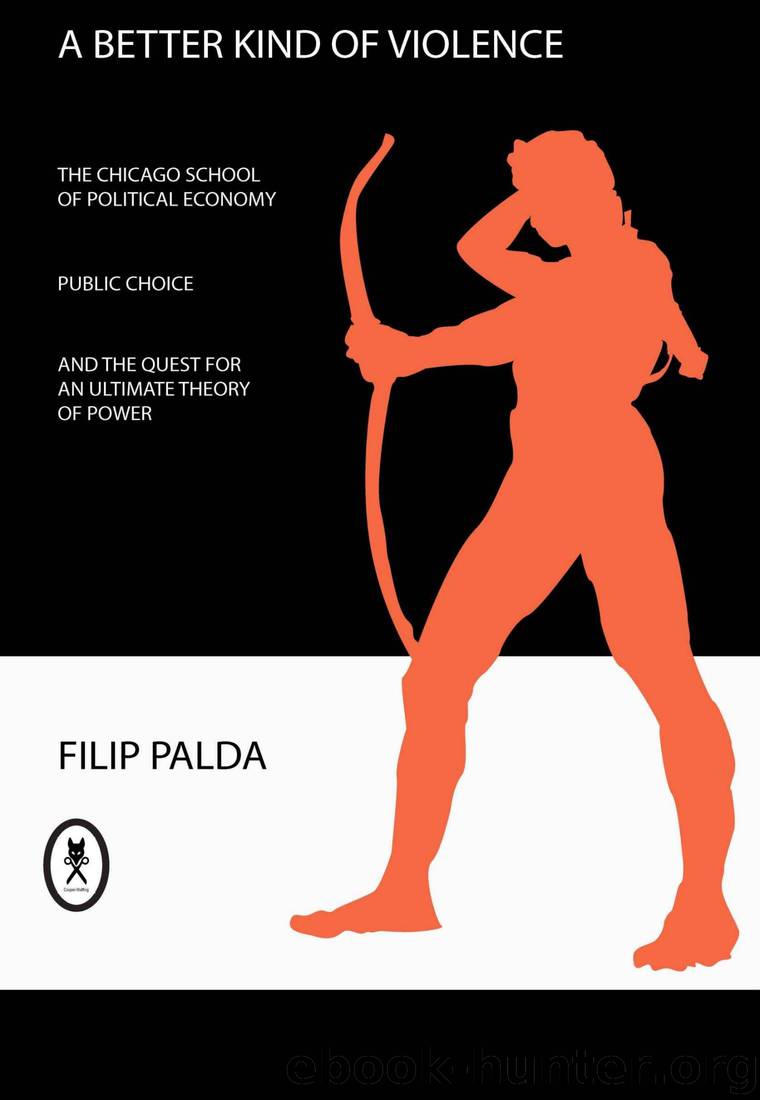A Better Kind of Violence by Filip Palda

Author:Filip Palda
Language: eng
Format: mobi
ISBN: 9780987788078
Publisher: Cooper Wolfling
Published: 2016-12-12T05:00:00+00:00
Summary
STIGLER DID NOT crank out a complete theory of power. His main interest was in discovering whether regulation was in the public interest. When he discovered the answer was “no” he perceived new dots which he tried to connect. The theory he attempted flapped its wings. Though it was not fully fledged it comprised three key insights that later researchers would fuse into a grander structure.
Stigler’s first insight is that government action is not a free good. August personages taking counsel whispered into their ears by messengers from Apollo are not the people we find in charge of government. Real world government agents are subject to interest groups exerting pressure upon them in order to seize control of the public purse or at very least to have a dip at the trough. Inspired by the general Chicago doctrine of “tight prior” Stigler hinted that these conflicts between interest groups might produce policies that could be considered economically efficient. This convergence towards efficiency would have the consequence that economists could forget about giving government advice. An efficient government would have converted all ideas on how to behave efficiently long before an economist had arrived on the scene to notice that some big bills had been left lying on the sidewalk.
The second insight was that two asymmetries influenced the structure of interest groups and the policies they pushed. Small groups with concentrated interests had an inbuilt advantage over large groups with diffuse interests. To the cab driver the loss of restrictions on the number of cabs can mean a reduction of thousands of dollars of revenue. To her fare greater competition between taxis might mean a savings of a few dozen dollars a year. Perhaps this is why a rail line skirts Miami Airport but does not stop there.
Yet small groups, or any group in fact that seeks to feed on others faces the harsh reality that its financial gain will be less than the financial harm it imposes on its victims due to collateral damage. The balance of these two asymmetries determines the structure that interest groups will take, the division of power between levels of government, and the types of redistributional policies undertaken. Redistribution that imposes severe collateral damage will be shunned in favor of more efficient means of extraction.
The third insight was that economic and political structures are deeply intertwined and mutually determining. If a firm such as an aerospace giant has no rivals in its country it will lobby government for direct cash subsidies. Firms with rivals would be better off simply keeping them out, so their best strategy would be to lobby for laws that restrict entry to their industry such as a production quota.
Political parties form in order to create and preserve a brand name that voters can easily recognize. These brand names are especially important to uneducated voters and surprisingly also to voters who earn high salaries and do not have the time to educate themselves on the particulars of party platforms. Parties also form
Download
This site does not store any files on its server. We only index and link to content provided by other sites. Please contact the content providers to delete copyright contents if any and email us, we'll remove relevant links or contents immediately.
International Integration of the Brazilian Economy by Elias C. Grivoyannis(57389)
The Radium Girls by Kate Moore(10915)
Turbulence by E. J. Noyes(7057)
Nudge - Improving Decisions about Health, Wealth, and Happiness by Thaler Sunstein(6643)
The Black Swan by Nassim Nicholas Taleb(6204)
Pioneering Portfolio Management by David F. Swensen(5616)
Rich Dad Poor Dad by Robert T. Kiyosaki(5162)
Zero to One by Peter Thiel(4834)
Man-made Catastrophes and Risk Information Concealment by Dmitry Chernov & Didier Sornette(4748)
Secrecy World by Jake Bernstein(3788)
Millionaire: The Philanderer, Gambler, and Duelist Who Invented Modern Finance by Janet Gleeson(3576)
Skin in the Game by Nassim Nicholas Taleb(3478)
The Age of Surveillance Capitalism by Shoshana Zuboff(3432)
The Money Culture by Michael Lewis(3291)
Skin in the Game: Hidden Asymmetries in Daily Life by Nassim Nicholas Taleb(3272)
Bullshit Jobs by David Graeber(3190)
The Dhandho Investor by Mohnish Pabrai(3176)
The Wisdom of Finance by Mihir Desai(3087)
Blockchain Basics by Daniel Drescher(2896)
